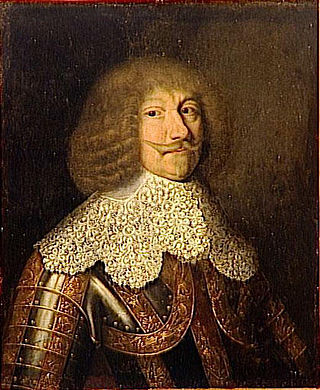Contents
| |||||
| Decades: | |||||
|---|---|---|---|---|---|
| See also: | Other events of 1626 History of France • Timeline • Years | ||||
Events of the year 1626 in France.
| |||||
| Decades: | |||||
|---|---|---|---|---|---|
| See also: | Other events of 1626 History of France • Timeline • Years | ||||
Events of the year 1626 in France.

The House of Bourbon is a dynasty that originated in the Kingdom of France as a branch of the Capetian dynasty, the royal House of France. Bourbon kings first ruled France and Navarre in the 16th century. A branch descended from the French Bourbons came to rule Spain in the 18th century and is the current Spanish royal family. Further branches, descended from the Spanish Bourbons, held thrones in Naples, Sicily, and Parma. Today, Spain and Luxembourg have monarchs of the House of Bourbon. The royal Bourbons originated in 1272, when Robert, the youngest son of King Louis IX of France, married the heiress of the lordship of Bourbon. The house continued for three centuries as a cadet branch, serving as nobles under the direct Capetian and Valois kings.

Louis XIII was King of France from 1610 until his death in 1643 and King of Navarre from 1610 to 1620, when the crown of Navarre was merged with the French crown.

MonsieurGaston, Duke of Orléans, was the third son of King Henry IV of France and his second wife, Marie de' Medici. As a son of the king, he was born a Fils de France. He later acquired the title Duke of Orléans, by which he was generally known during his adulthood. As the eldest surviving brother of King Louis XIII, he was known at court by the traditional honorific Monsieur.
Duke of Orléans was a French royal title usually granted by the King of France to one of his close relatives, or otherwise inherited through the male line. First created in 1344 by King Philip VI for his younger son Philip, the title was recreated by King Charles VI for his younger brother Louis, who passed the title on to his son and then to his grandson, the latter becoming King Louis XII. The title was created and recreated six times in total, until 1661, when Louis XIV bestowed it upon his younger brother Philippe, who passed it on to his male descendants, who became known as the "Orléans branch" of the Bourbons.

Marie Aimée de Rohan was a French courtier and political activist, famed for being the center of many of the intrigues of the first half of the 17th century in France. In various sources, she is often known simply as Madame de Chevreuse.

Louis de Bourbon, Comte de Soissons was the son of Charles de Bourbon, Count of Soissons and his wife, Anne de Montafié, Countess of Clermont-en-Beauvaisis. A second cousin of Louis XIII of France he was a prince du Sang, those considered part of the royal family. Part of the faction who opposed Cardinal Richelieu and his policy of war with Spain, he was killed leading a revolt at the Battle of La Marfée in 1641.

Henri de Talleyrand-Périgord, comte de Chalais (1599–1626) was a favorite of Louis XIII of France.

César de Bourbon, Légitimé de France was the illegitimate son of Henry IV of France and his mistress Gabrielle d'Estrées, and founder of the House of Bourbon-Vendome. He held the titles of 1st Duke of Vendôme, 2nd Duke of Beaufort and 2nd Duke of Étampes, but is also simply known as César de Vendôme.

Roger II de Saint-Lary, seigneur de Termes, duc de Bellegarde, nephew of Roger de Saint-Lary de Bellegarde, was a French duke.

The House of Talleyrand-Périgord is an ancient French noble house. A well-known member of this family was Charles Maurice de Talleyrand-Périgord (1754–1838), who achieved distinction as a French statesman and diplomat. The family name became extinct in 2003 upon the death of Violette de Talleyrand-Périgord.

Marie de Bourbon, Duchess of Montpensier, Princess of Dombes and Duchess of Orléans by marriage, was a French noblewoman and one of the last members of the House of Bourbon-Montpensier. Her parents were Henri de Bourbon, Duke of Montpensier and Henriette Catherine de Joyeuse, Duchess of Joyeuse in her own right.

The House of Bourbon-Montpensier or Maison de Bourbon-Montpensier was a semi royal family. The name of Bourbon comes from a marriage between Marie de Valois, comtesse de Montpensier (1375–1434) who married Jean de Bourbon - the duc de Bourbon. The second name of Montpensier, comes from the title of the family.
Events of the year "1642 in France".

Charles de La Vieuville first styled Marquis of La Vieuville but later created 1st Duke of La Vieuville was an important French noble and Superintendent of Finances of France from 1623 to 1624 and once again from 1651 to 1653.

Jean-Baptiste d'Ornano, Marquis de Montlaur (1581–1626) was a French nobleman and Marshal of France (1626).

Nicolas de L'Hôpital de Vitry was a French noble, military leader, and friend of Louis XIII. Made Marshal of France in 1617, he was often called Maréchal de Vitry. His noble title was marquisde Vitry; he was also seigneur de Nandy et de Coubert.
Events from the year 1634 in France.

The Chalais conspiracy was a 1626 conspiracy in France directed against Cardinal Richelieu, Louis XIII's chief minister. It was the first, but not the last conspiracy of the nobility against the minister. The conspiracy is named after Henri de Talleyrand-Périgord, comte de Chalais, who confessed it to the king and the cardinal and was later executed for his part in it.